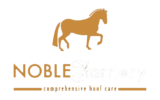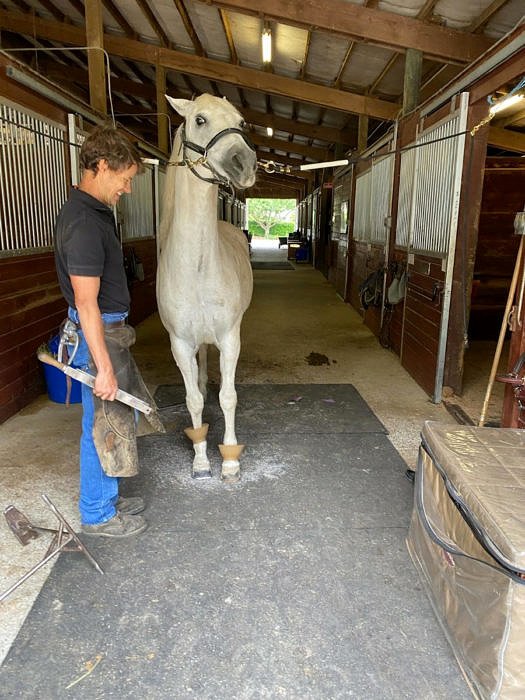The Noble Farriery Signature Trim is foundational to Noble Farriery’s proven success in maintaining the health of horses. There are countless approaches to trim out there, and the debate about best practices will continue. But we stand by The Noble Farriery Signature Trim because of the actual results we have seen over the years, in regular hoof maintenance and in full-on therapy.
NW Horse Source spoke with Seth Noble, founder of Noble Farriery, and Sara Perkins, DVM about The Noble Farriery Signature Trim. We invite you to read the full article, but we also want to share some choice passages. For those who don’t know about The Noble Farriery Signature Trim, this is a great place to start.
As the article points out, a lot of problems can stem from improper hoof angles and low heels. Using The Noble Farriery Signature Trim, we start from the top and bring the toe and flares back. This helps prevent over trimming while the angle and shape are refined.
Injury to the high suspensory ligaments of the hind legs is just one salient example of how an improper trim negatively affect a horse. As Sara Perkins in NW Horse Source states:
Many horses with this injury have low heels and are at an incorrect (negative) angle which puts extra stress on the suspensory ligament. Correcting the feet will give the horse the greatest chance for long term soundness.
In the past, we tried trailers, wedges, and various corrective shoes. Currently, we are having great success with farrier Seth Noble’s method of a regular shoe (set carefully to ensure proper break over) along with a frog support pad and impression material. This adds depth and support, taking stress off the ligament. This modality along with proper rehabilitation has greatly improved the outcome for horses with suspensory injuries.
The question of trim is in part so hotly debated because it is both a matter of function and aesthetic. What has been codified as pretty (and therefore correct) may not always be best for the horse depending on its conditions and routines.
Noble has noted that the suspensory ligament injury is quite common in English riding disciplines, and the trim may often be at issue. The foot conformation in these cases keeps the coffin bone at a negative angle. To visualize this in human terms, Noble likens a negative angle to “walking around on your heels with your toes off the ground.”
The stride of the horse compensates for this angle by hitting toe first. “As the horse’s weight moves to the rear of the foot, the pastern snaps upward into a high angle and stresses the suspensory ligament,” as NW Horse Source further explains. Hence, treating ligament injuries begins with raising the hoof angle, thereby lowering the pastern angle. This allows the hoof to hit heel first.
In conjunction with ligament injury, this trim issue also often results in the foot is being broken down from being overtaxed. To treat this injury orthotically, Noble uses shoes and pads with silicone packing, adding support to the rear of the foot and helping tip the weight-bearing forward.
To again quote the article:
Success with a difficult injury such as this highlights the importance of proper shoeing and the influence it has on the horse. In any case of lameness, poor performance, or working to optimize performance, hoof care is one of the most important and powerful factors.
We are grateful to NW Horse Source for sharing the good word about The Noble Farriery Signature Trim. The core ethos of our work at Noble Farriery is faithful, restorative service to the animals we love so much. Seeing the results of our work in treating such injuries as in high suspensory ligaments is inspiring to us, and it looks like it has been to others, too. Thanks again, NW Horse Source.


Leave a Reply
You must be logged in to post a comment.